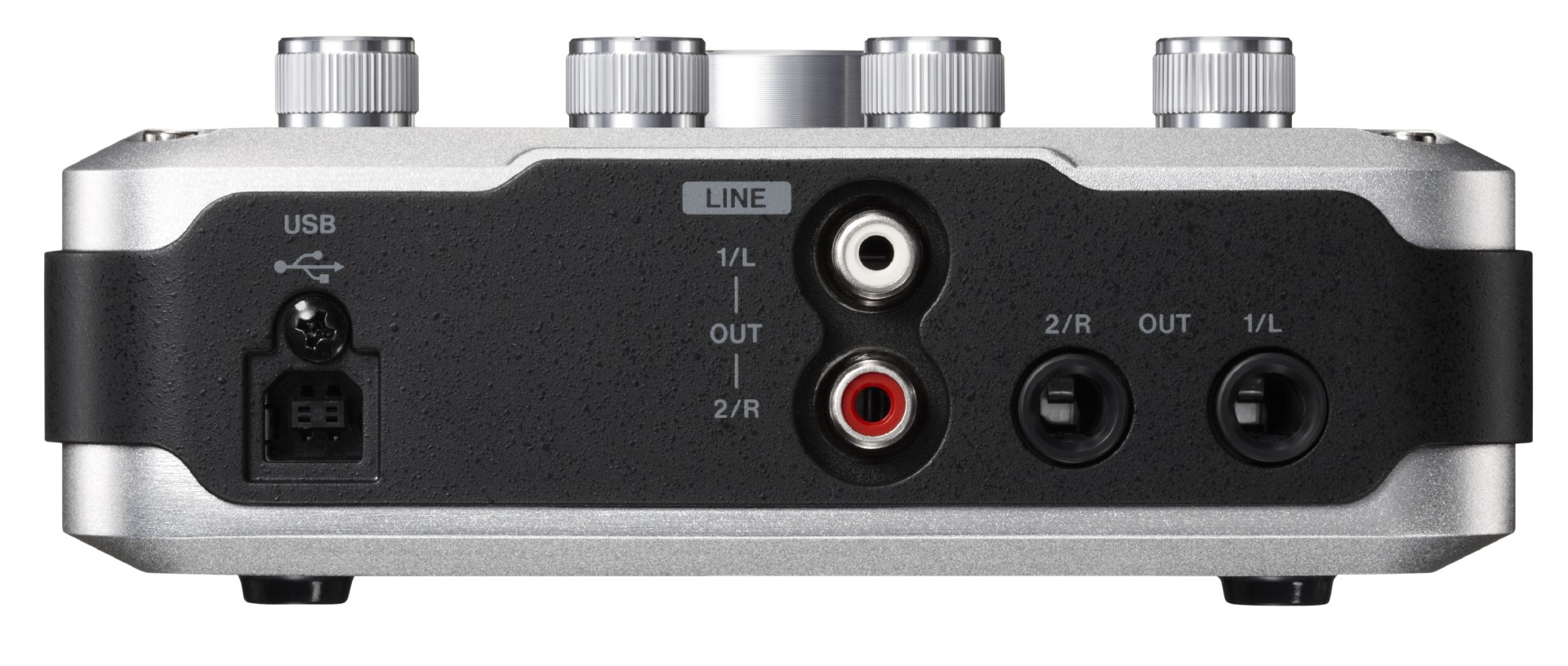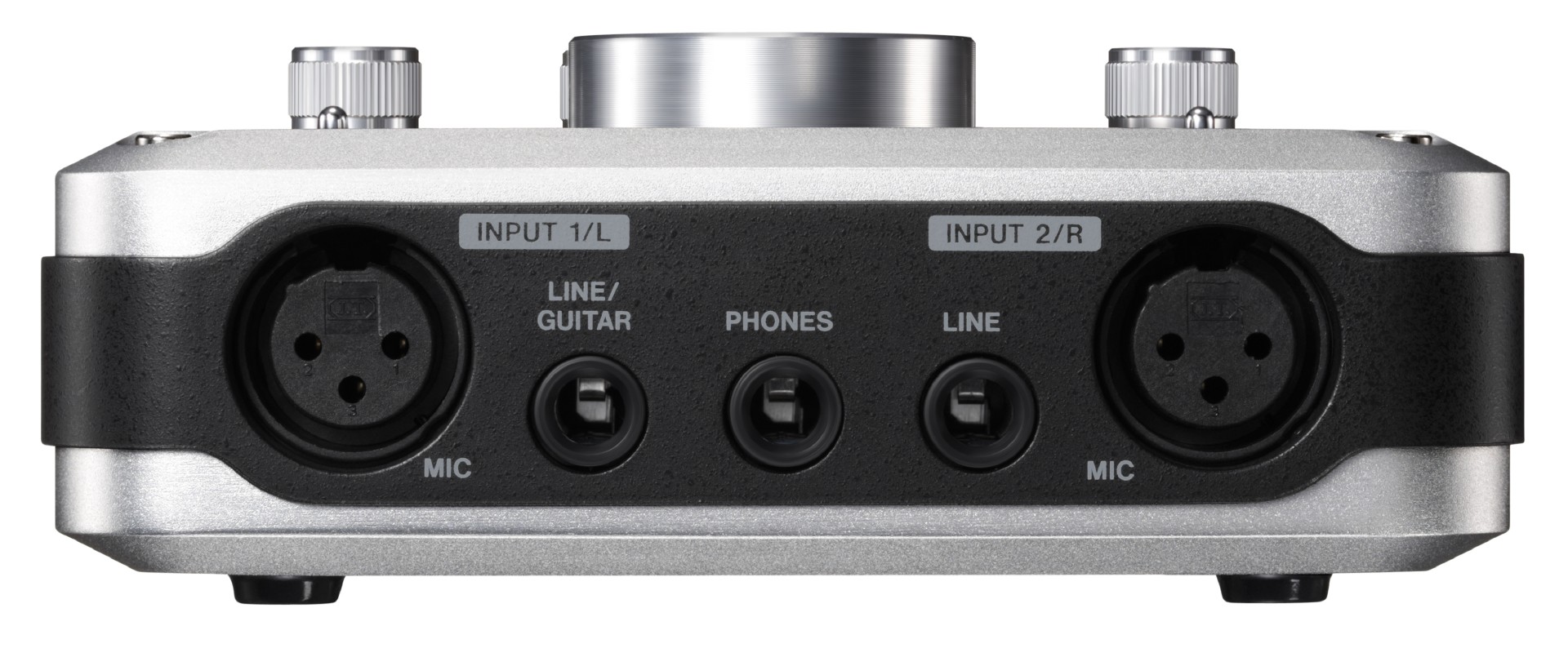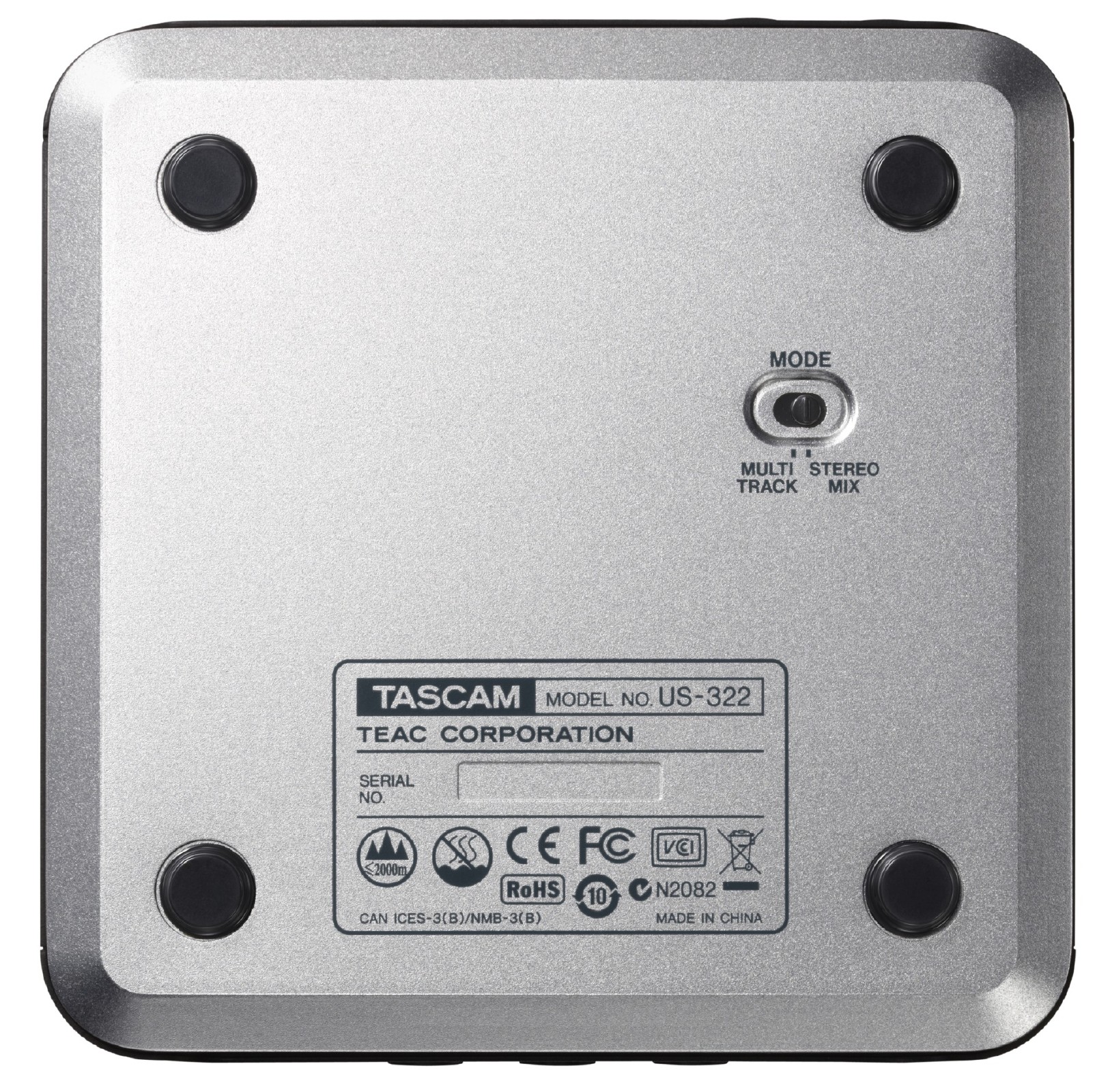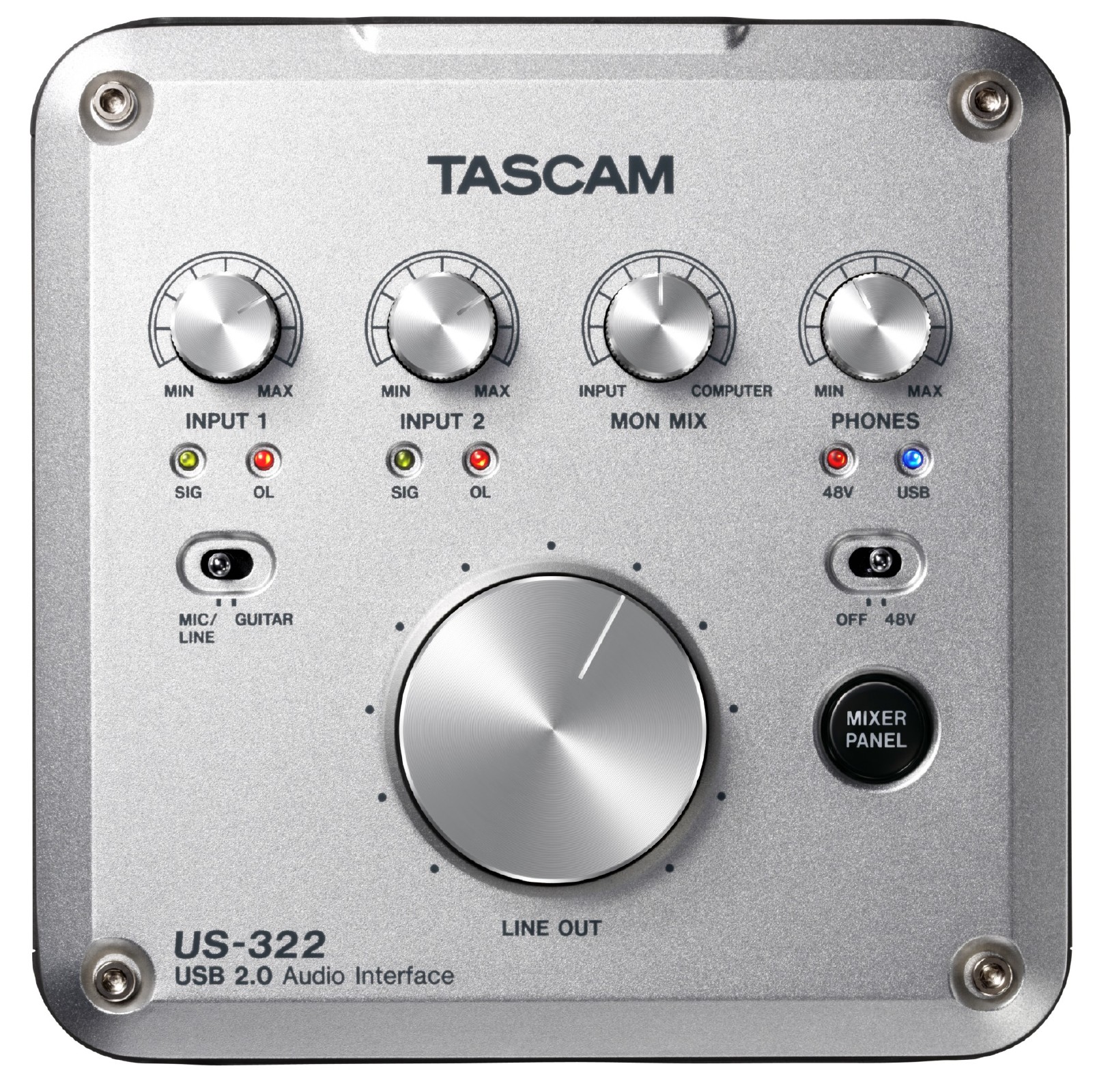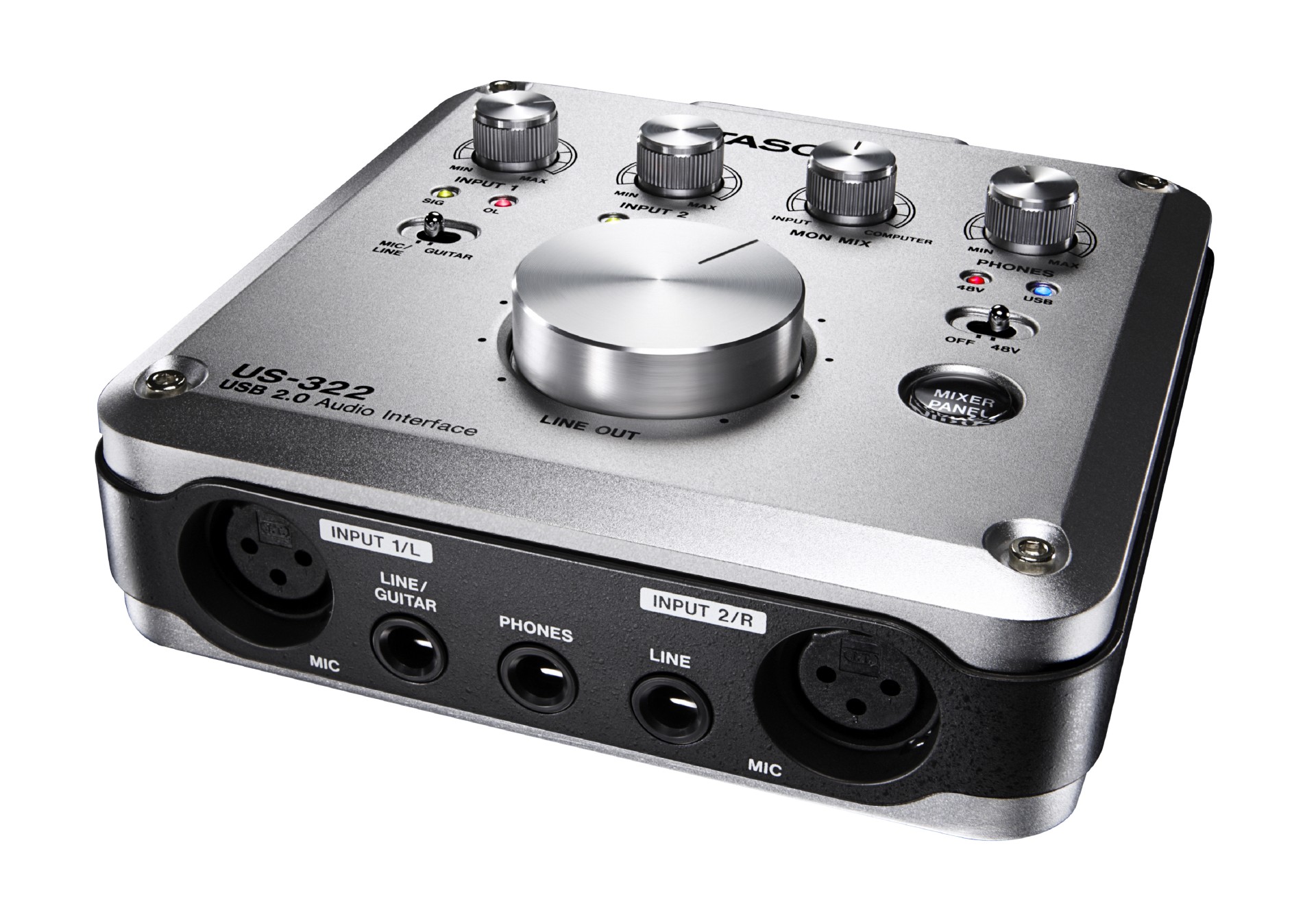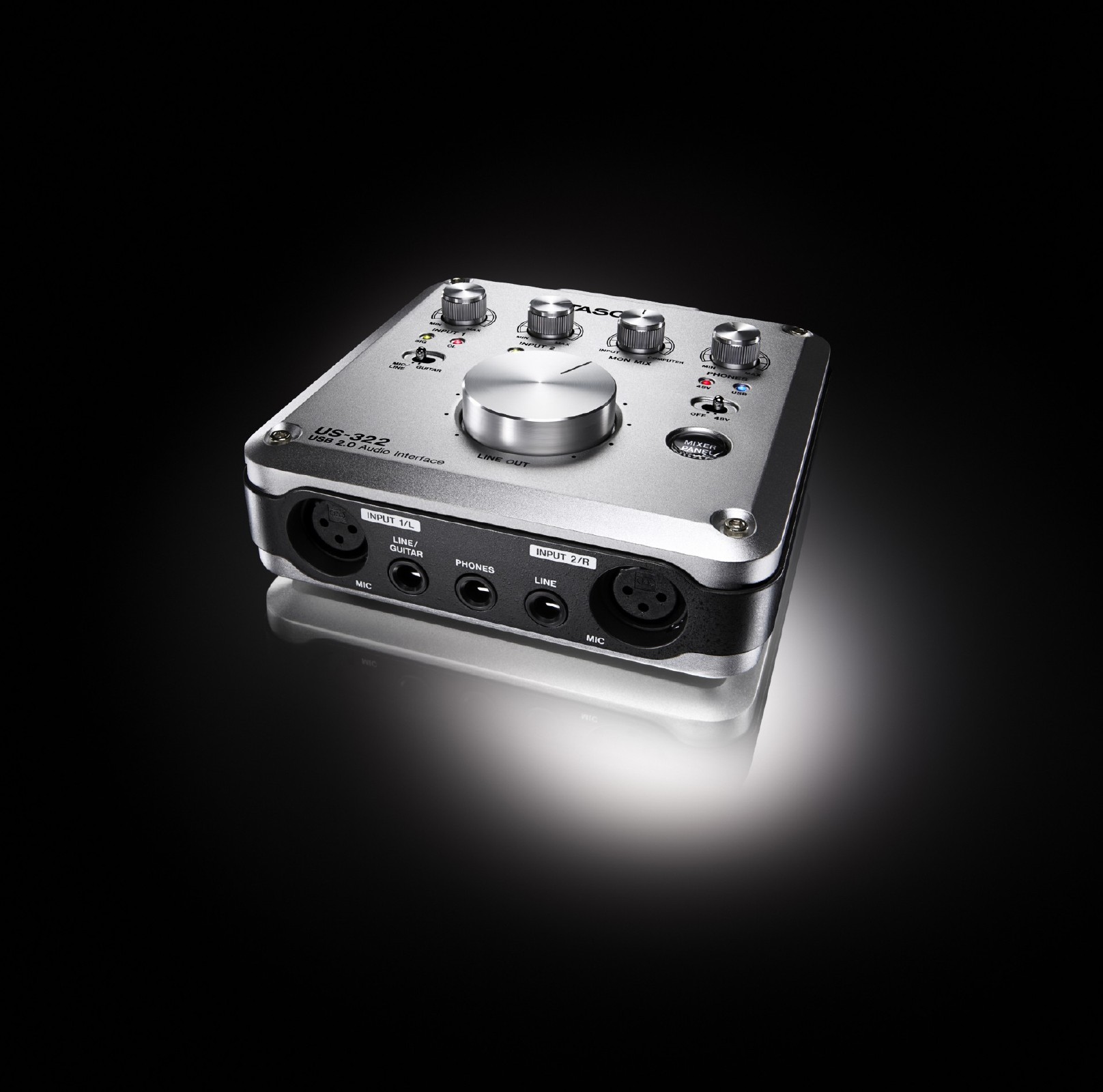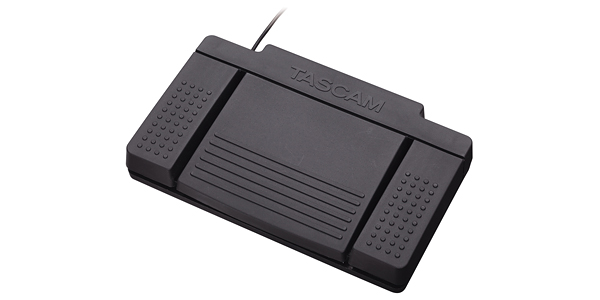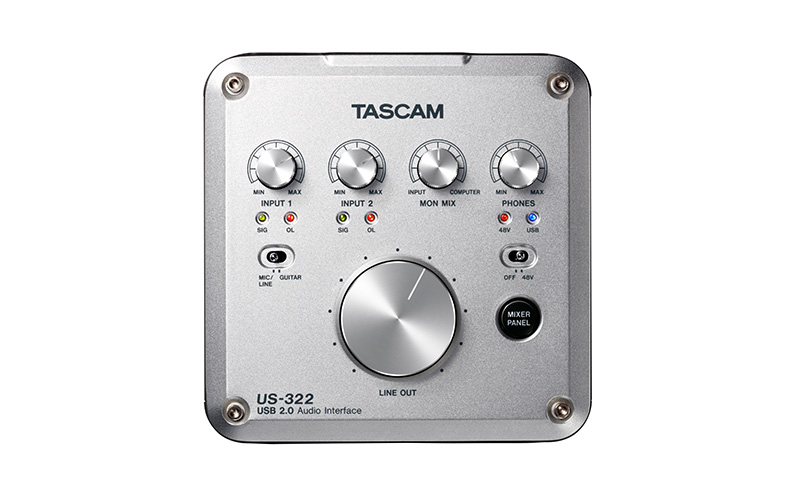
This model has been discontinued.
It has been replaced with the US-2x2.

High-Quality HDDA Mic Pre-Amps and a Wealth of Features for Superior Sound.
USB 2.0 Audio Interface with On-Board DSP Mixer and up to 96/192kHz Recording.
LINEUP
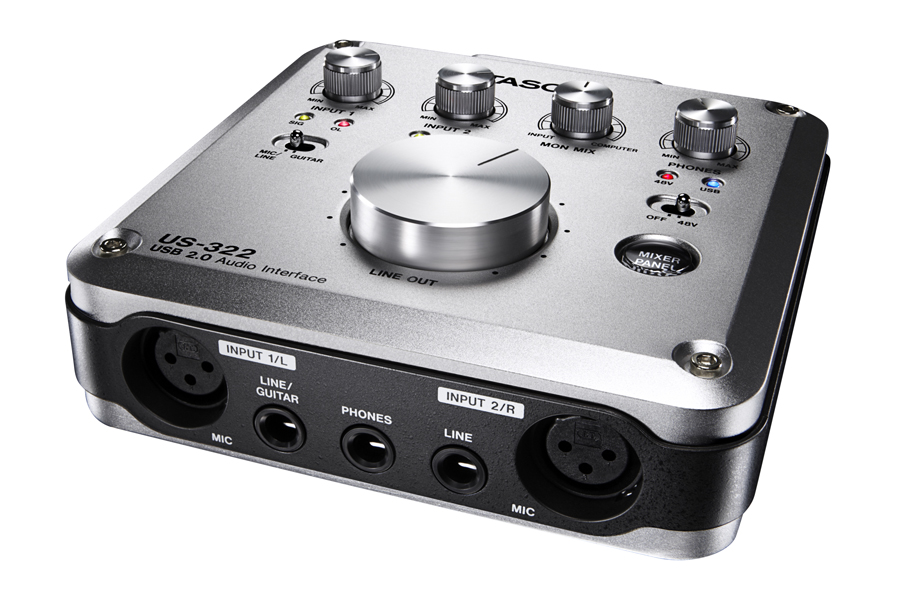 US-322 |
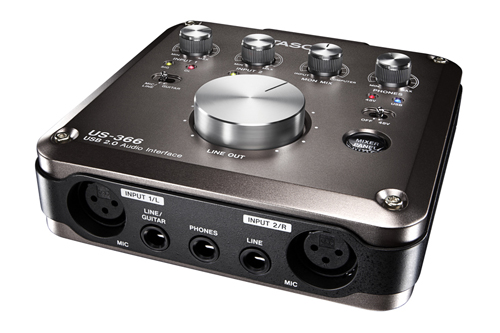 US-366 |
Main Features
| High-Performance Hardware For High-Quality Sound Recording | To TOP |
- High-Quality HDDA – High Definition Discrete Architecture – Mic Pre-Amplifiers
-
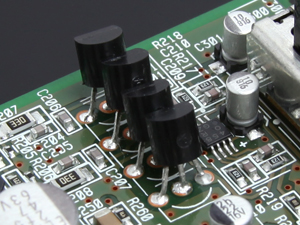
To ensure superior sound, TASCAM organized months of tests and trials to design the HDDA mic pre-amplifier. Manufactured with a discrete structure and select premium parts, the HDDA pre-amp achieves wider frequency response (10Hz to 68kHz), high S/N ratio, low noise and low THD+N. - US-366: Up to 192kHz/24bit Recording – US-322:Up to 96kHz/24bit Recording
- In the process of creating music, many engineers have started utilizing high-resolution formats while recording to ensure the best quality sounds. The US-322 and the US-366 are suited perfectly for these high-quality minded recordings.
(Included CUBASE LE can not record by 192kHz) - Two XLR/TRS (MIC/LINE) Inputs with Full +48V Phantom Power Supply
-
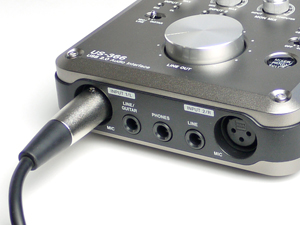
The US-322 and the US-366 are designed with two XLR with +48V phantom power and two TRS inputs. Having both options for condenser mics and line level inputs ensures you are getting the best possible sound and lowest-noise when recording. In addition, INPUT-1 can connect any high-impedance equipment directly, like a guitar.
| On-Board Digital Mixer (DSP Mixer) for Easy, Convenient Professional Recording | To TOP |
- The DSP Mixer Has Two Operational Modes Designed for Music Creation and Podcasting
- The DSP mixer function provides a multi-track mode and a stereo-mix mode.
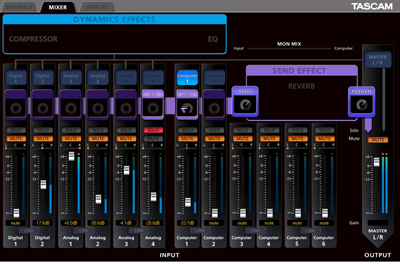
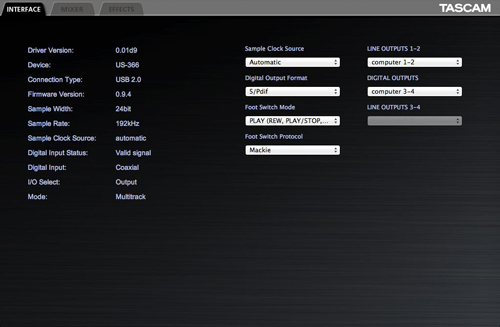
Multi-track Mode
The multi-track mode is ideal for music creation. This mode delivers independent monitor-mixing from a send-level like an inline-console to a PC. In addition, this mode delivers monaural-monitoring.Stereo-mix Mode
The stereo-mix mode makes podcast recording or broadcasting convenient and easy. An output audio signal from any PC can relay that signal back to the PC again via your DSP mixer. Any BGM from a PC can mix your voice by microphone then the mixed sound will transfer back to the PC again. - On-Board Effects Supports High-Quality Recording (Send Effects and Insert Effects)
- The US-322 and the US-366 are designed with on-board effects such as compressor, 3-band EQ and Reverb all located on-board the DSP. While recording, you can use the input effects for any input signal and the reverb effect on any monitoring signal at the same time.
(DSP effects can use on 44.1/48kHz operating)
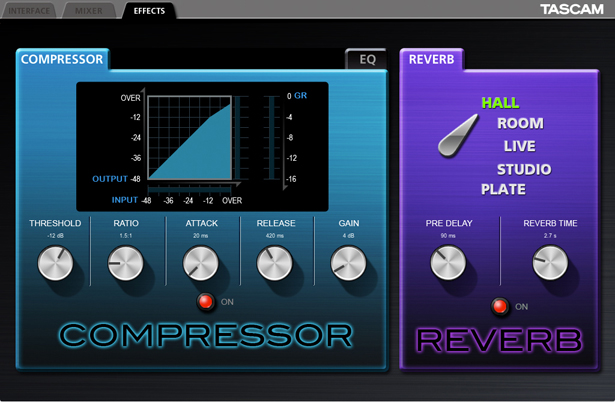
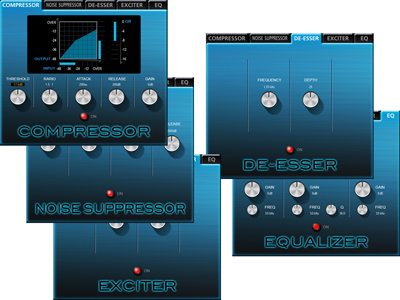
Insert Effects
The input effects can be selected from compressor or 3-band EQ. Input effects can use various recording. For example, while recording vocals you can boost your high-frequency range with the 3-band EQ. Also, the compressor effect is very convenient at recording especially for bass guitar, vocal and drums.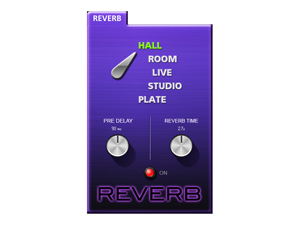
Send Effect
The send effect include just reverb. The reverb effect is necessary articles at recording. Monitoring sound will get wet-sound by this reverb effect, but a send-sound to a PC keeps just dry sound. - Dedicated MIXER PANEL Button Recalls The DSP Mixer with One-Click
-
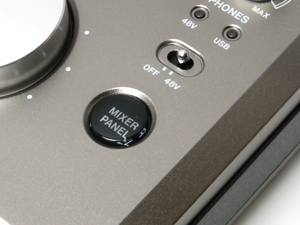
The US-322 and the US-366 are built with a "MIXER PANEL" button located conveniently on top. This button provides a one-click recall function for the DSP-mixer. When pushed a second time the mixer panel will be conveniently hidden.
| Suited for Various Recording Environments with Adaptable Features | To TOP |
- Low-Latency Monitoring via DSP Mixer for Stress-Free Recording
-
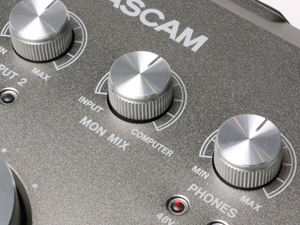
The US-322 and the US-366 provide low-latency monitoring via the on-board digital mixer. Volume can be monitored and adjusted easily with the dedicated knob on the top-panel. - Oversized LINE OUT Volume Knob for Easy Monitor Level Setting
-
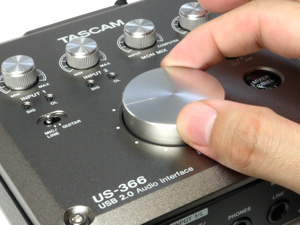
This oversized volume knob can be an integral setting for easy and speedy fine level adjustments. - Classy Desktop Design, Luxurious Feel and Rugged Aluminum Body
-
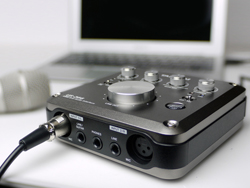
The US-322 and the US-366 look so good, you'll be motivated to use it. The adopted "Desktop Layout" makes these models easy-to-use even in tight spaces.
| Dedicated the US-366 Features | To TOP |
- LINE 3-4 Analog Connectors – Select Between Input or Output, Up to Six Inputs or Six Outputs
- The US-366's LINE 3-4 connectors can be selected between input and output to customize TASCAM's US-366 to any recording environment. When "INPUT" is selected, you can connect an abundance of line-level audio devices. When selecting "OUTPUT", connect to devices such as multiple headphone amplifiers. This system provides dedicated monitoring management for each player.
(When operating on 192kHz, LINE 3-4 connectors outputs same signal as digital output.)

- Coaxial/Optical Digital Inputs/Output
-
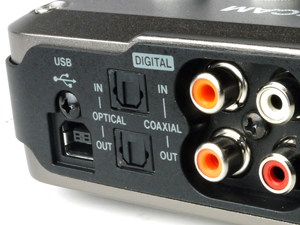
The US-366 has two types of digital input/output connectors (RCA Coaxial and TOS-link Optical). Two outputs can transmit the same signal at the same time but when input is selected, only one connector is available at a time. - RC-3F Foot Switch Ready –Control Your DAW Hands-Free
-
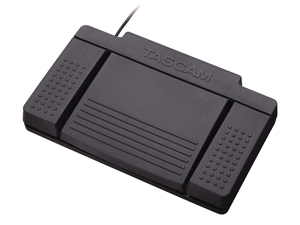
The US-366 can connect the optional RC-3F foot-switch to provide hands-free control for your DAW. Utilize this feature while playing your instrument or recording at a distance from your computer. This feature operating on "Mackie Control" or "HUI" emulation and can be select from two modes.
PLAY mode: RW, PLAY/STOP, FF
REC mode: PLAY, REC, STOP
|
Features at a glance |
To TOP |
- High-quality HDDAHigh Definition Discrete Architecture) mic pre-amps
- Up to 24bit/96kHz recording(US-366 supported 24bit/192kHz recording)
- Two XLR/TRS (MIC/LINE) inputs with full +48V phantom power supply
- Low-latency monitoring via DSP mixer
- On-board digital mixer(DSP mixer) delivers two operation modes
- On-board digital effects(DSP effects)(DSP effects can use on 44.1/48kHz operating)
- Dedicated "MIXER PANEL" button recalls DSP mixer with one-click
- Oversized LINE OUT volume knob
- Two TRS analog balanced outputs
- Two RCA analog unbalanced outputs
- 18mW+18mW headphone output
- Desktop design provides highly stability and usability
- Aluminum body provides premium looks and luxurious feel
- USB bus-powered for mobile recording
Underlined features are the US-366 only
- Up to 24bit/192kHz recording
- LINE 3-4 connectors can select between input or output, up to six inputs or six outputs(When operating on 192kHz, LINE 3-4 connectors outputs same signal as digital output.)
- Coaxial/Optical digital input and output (one input connector available at a time)
- RC-3F optional footswitch ready
Option
|
Spec description
| US-366 | US-322 | |
| Supported sampling frequency | 44.1/48/88.2/96/176.4/192kHz | 44.1/48/88.2/96kHz |
| Supported bit rate | 16/24bit (Internal operation is 24bit) | |
| Analog audio Inputs | ||
| MIC IN (INPUT 1/L, 2/R) |
XLR-3-31(1:GND, 2:HOT, 3:COLD), BALANCED | |
| Input impedance | 2.2kohms | |
| Nominal input level (INPUT:MAX) |
-65dBu | |
| Nominal input level (INPUT:MIN) |
-22dBu | |
| Maximum input level (INPUT:MIN) |
-6dBu | |
| LINE IN (INPUT 1/L, 2/R) |
6.3mm(1/4") TRS-jack(T:HOT, R:COLD, S:GND), BALANCED | |
| Input impedance | 15kohms(LINE)/1Mohms(GUITAR) | |
| Nominal input level (INPUT:MAX) |
-39dBu(LINE)/-55dBV(GUITAR) | |
| Nominal input level (INPUT:MIN) |
+4dBu(LINE)/-12dBV(GUITAR) | |
| Maximum input level (INPUT:MIN) |
+20dBu(LINE)/+4dBV(GUITAR) | |
| LINE IN (LINE I/O 3-4) |
RCA pin-jack (When set to "INPUT" at LINE I/O switch) |
- |
| Input impedance | 15kohms | - |
| Nominal input level | -10dBV | - |
| Maximum input level | +6dBV | - |
| Analog audio outputs | ||
| LINE OUT (LINE OUT 1/L, 2/R) |
6.3mm(1/4") TRS-jack(T:HOT, R:COLD, S:GND), BALANCED | |
| Output impedance | 100ohms | |
| Nominal output level | +4dBu | |
| Maximum output level | +20dBu | |
| LINE OUT (US-366:LINE I/O 3-4) (US-322:LINE I/O 1-2) |
RCA pin-jack (When set to "OUTPUT" at LINE I/O switch) |
|
| Output impedance | 200ohms | |
| Nominal output level | -10dBV | |
| Maximum output level | +6dBV | |
| Digital audio inputs | ||
| COAXIAL (DIGITAL IN) |
RCA pin-jack (When set to "COAXIAL" at DIGITAL IN switch) |
- |
| Format | IEC60958-3(S/P DIF) | - |
| OPTICAL (DIGITAL IN) |
TOS (JEITA RC-5720C) (When set to "OPTICAL" at DIGITAL IN switch) |
- |
| Format | IEC60958-3(S/P DIF) | - |
| Digital audio outputs | ||
| COAXIAL (DIGITAL OUT) |
RCA pin-jack | - |
| Format | IEC60958-3(S/P DIF)/ IEC60958-4(AES/EBU)* | - |
| OPTICAL (DIGITAL OUT) |
TOS (JEITA RC-5720C) | - |
| Format | IEC60958-3(S/P DIF)/ IEC60958-4(AES/EBU)* | - |
| *Output format can be selected ”S/P DIF” or ”AES/EBU” on INTERFACE tab of DSP mixer. | ||
| PHONES | ||
| Connector | 6.3mm(1/4") stereo phone jack | |
| Maximum output level | 18mW+18mW or more(THD+N 0.1% or less, 32ohms loaded) | |
| USB | ||
| Connector | USB B type 4-pin | |
| Format | USB2.0 HIGH SPEED mass storage class | |
| REMOTE | ||
| Connector | 2.5mm TRS-jack | - |
| Supported protcol | Dedicated protocol for RC-3F (Mackie Control or HUI emulation) |
- |
| Power | USB bus powered (5V, Max 500mA) | |
| Power consumption | 2.5W | |
| Dimensions | 140(W)×42(H)×140(D)mm | |
| Weight | 500g | |
| Operating temperature | 5-35˚C | |
| Audio performance | ||
| ADC chip set dynamic range | 102dB *1 | |
| DAC chip set dynamic range | 106dB *2 | |
| Frequency response | ||
| Mic preampr | 10Hz to 68kHz, +0.5/-3.0dB | |
| MIC IN to LINE OUT | 10Hz to 68kHz, +0.5/-3.0dB | 10Hz to 40kHz, +0.5/-3.0dB |
| MIC IN to PHONES | 10Hz to 30kHz, +0.5/-1.0dB | |
| THD | 0.0045% or less *3 | |
| S/N ratio | 98dB or more *4 | |
| EIN | -120dBu or less *5 | |
| Operating system requirements | |
| Windows | |
| OS | Windows XP(32-bit SP3, 64-bit SP2), Windows 7(32-bit SP1, 64-bit SP1), Windows 8.0(32-bit, 64-bit), Windows 8.1(32-bit, 64-bit) * For further information of the latest OS version, please click here. |
| DRIVER | ASIO2.0, WDM(MME) |
| Macintosh | |
| OS | Mac OS X Snow Leopard(10.6.8), OS X Lion(10.7), OS X Mountain Lion(10.8), OS X Mavericks(10.9) * For further information of the latest OS version, please click here. |
| DRIVER | Core Audio |
| *1 | FS=48kHz, A-Weight |
| *2 | FS=44.1kHz, A-Weight |
| *3 | US-366:MIC IN to LINE OUT, INPUT 1/2 knobs at MIN position, FS=176.4/192kHz, JEITA US-322:MIC IN to LINE OUT, INPUT 1/2 knobs at MIN position, FS=88.2/96kHz, JEITA |
| *4 | US-366:MIC IN to LINE OUT, INPUT 1/2 knobs at MIN position, FS=176.4/192kHz, JEITA US-322:MIC IN to LINE OUT, INPUT 1/2 knobs at MIN position, FS=88.2/96kHz, JEITA |
| *5 | US-366:MIC IN to LINE OUT, INPUT 1/2 knobs at MAX position, FS=176.4/192kHz, JEITA US-322:MIC IN to LINE OUT, INPUT 1/2 knobs at MAX position, FS=88.2/96kHz, JEITA |
Supported OS' (PC)
Windows
Windows 10 (May 2019 Update) , Windows 8.1 , Windows 8 , Windows 7 , Windows XPMac
macOS Mojave , macOS High Sierra (10.13) , macOS Sierra (10.12) , OS X El Capitan (10.11) , OS X Yosemite (10.10) , OS X Mavericks (10.9) , OS X Mountain Lion (10.8) , OS X Lion (10.7) , Mac OS X Snow Leopard (10.6)Manuals
| Quick Start Guid (English) | 01-10-2018 | 946.1 KB |
|---|---|---|
| Owner's Manual (English) | 06-08-2014 | 3.2 MB |
Documents
| Installation Guide for macOS Mojave and macOS High Sierra | 10-02-2019 | 629.3 KB |
|---|---|---|
| Release Notes | 08-25-2015 | 1.1 MB |
| How to install Cubase LE | 05-08-2014 | 4.1 MB |
| US-322 & US-366 release notes | 04-03-2013 | 576.9 KB |
| Cubase LE quick start guide | 04-03-2013 | 1.1 MB |
Firmware
| Firmware V1.03 for OS X Mavericks and Yosemite | 12-01-2014 | 85.0 KB |
|---|---|---|
| Firmware V1.03 for Windows | 12-01-2014 | 2.5 MB |
| Firmware Updater V1.02 (Win) | 07-29-2013 | 291.5 KB |
| US-322/US-366 Firmware Updater V1.02 (Mac) | 07-26-2013 | 85.2 KB |
Windows Drivers
| Driver V1.04 for Windows | 08-25-2015 | 13.4 MB |
|---|---|---|
| Driver V1.02 for Windows XP | 07-29-2013 | 8.4 MB |
Mac Drivers
| Driver V3.23 (macOS Sierra / macOS High Sierra / macOS Mojave only) | 10-03-2016 | 5.5 MB |
|---|---|---|
| Driver V3.22rc5 (OS X Mavericks, OS X Yosemite and OS X El Capitan only) | 12-28-2015 | 4.5 MB |
| Driver V3.01 Release Notes (OS X Mavericks and Yosemite only) | 05-09-2014 | 760.4 KB |
| Driver V1.02 (OS X / Mac OS X) | 07-26-2013 | 9.0 MB |
FAQs
In case that 24 bit is being selected at the setting of "Select the sample rate and bit depth to be used when running in shared mode" on Windows, PC is re-booted up when system sound on Windows is played.
Please check here for how to avoid it.
Cubase LE is authorized on the Steinberg website. Go to this page to get started.
According to Apple, OS X 10.9.5 includes heightened security measures that will also be part of OS X 10.10. These security measures will affect some TASCAM audio interfaces, so users are advised to be aware, and hold off on updating until further information is available
These products use Apple's built in CoreAudio driver. The Settings Panel installer is fully compliant with Apple's latest security measures.
- US-2x2
- US-4x4
The latest drivers are compliant, but testing is ongoing for these products:
- US-322
- US-366
- US-1200
- UH-7000
The OS X 10.9 public beta drivers can continue to be used for these interfaces:
- US-122mkII
- US-144mkII
- US-200
- US-600
- US-1641
- US-1800
- US-2000
Cannot be used with the current driver (public or beta):
- IF-FW/DMmkII: Development is on-going and a version that is compliant with the new security measures will be made available as soon as possible. Please keep your system at 10.9.4 or earlier if you wish to continue to use the IF-FW/DMmkII.
- TASCAM Mixer Companion: Gatekeeper Security must be set to "allow all" for TMCompanion to be installed. It can be reverted to higher security settings after installation.
- Other audio interface products not mentioned are no longer supported.
In certain software (e.g. Skype), you can only access one input when the interfce is in Multitrack mode. Flip the interface over and move the switch to Stereo Mix mode.
You need to set the Mac OSX sound output to be the US-322/366 and then map through that.
- Open System Preferences and click on Sound
- In the output tab, choose the US-322/US-366. Repeat in the Input tab.
- Open Premiere, open Preferences, and click on Audio Hardware
- Set Adobe Desktop Audio to US-322/US-366
- Set "Map Output for" to Adobe Desktop Audio
Please be aware that this activation system is designed and controlled by Steinberg and not TASCAM.
- Install Cubase LE 4 or Cubase LE 5
- Make sure that your computer has a working Internet connection. This connection is necessary to activate the license because the eLicenser Control Center (eLCC) needs to register with our license server.
- Make sure that you have the latest version of the eLCC installed. Click here to download
- Open the eLicense Control Center (eLCC) software and make a note of your Soft-eLicenser number
- Create a user account in the MySteinberg area. If you already have one, please go to step 7.
- The "My Steinberg" area can be found on the Steinberg home page
- Check your email and activate your user account by clicking the link in the confirmation email
- Log in to your MySteinberg account, and click on "Activation & Reactivation", choose "Cubase LE 4" or "Cubase LE 5" and select "Permanent Activation". Enter your Soft-eLicenser and choose your hardware manufacturer
- You will receive an email containing the activation code
- Launch the eLicenser Control Center software. Click the "Enter Activation Code" button to download the license for your Steinberg product to the Soft-eLicenser. To do this, enter the required activation code into the corresponding field. Follow the instructions on screen.
The process above is taken directly from the Steinberg website. Cubase LE4 Cubase LE5
If you are still having problems after following the above instructions, consider posting a message on the Cubase.Net forum


